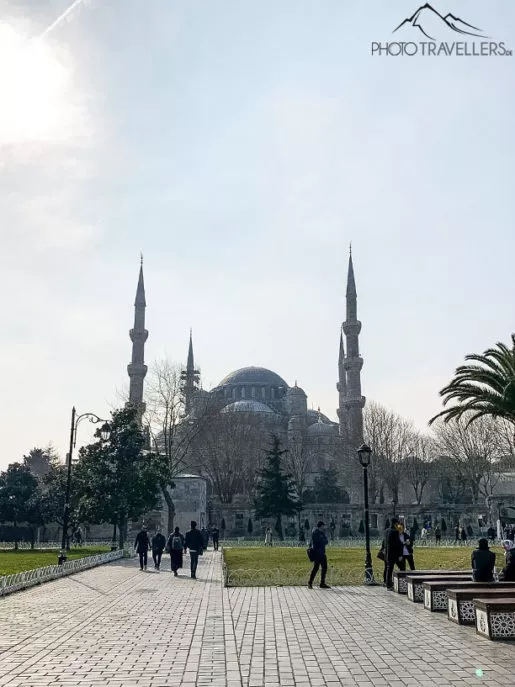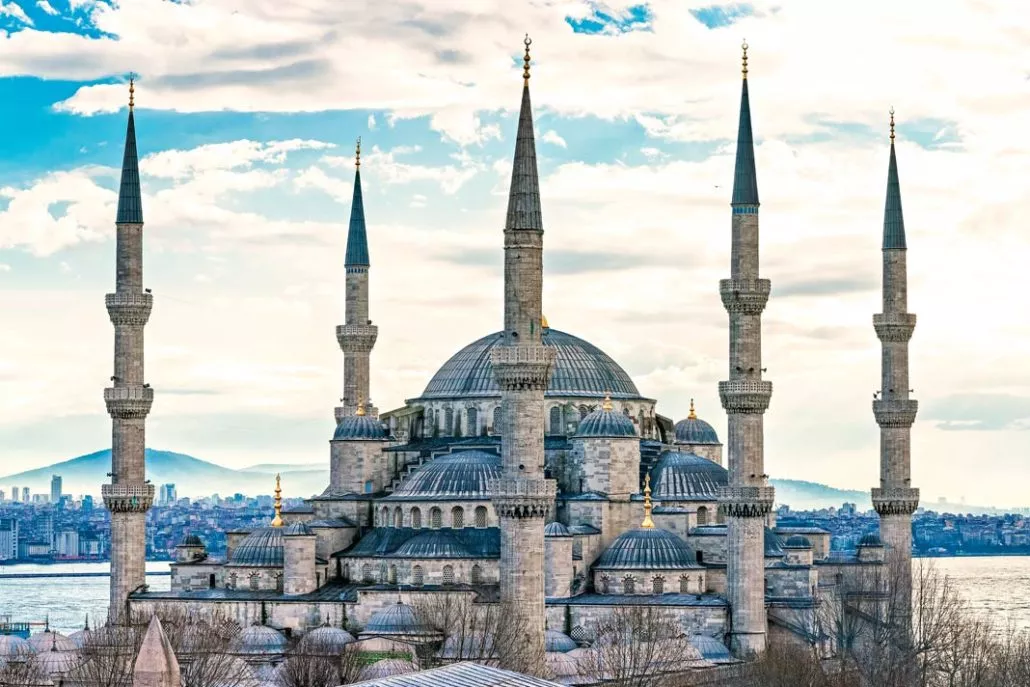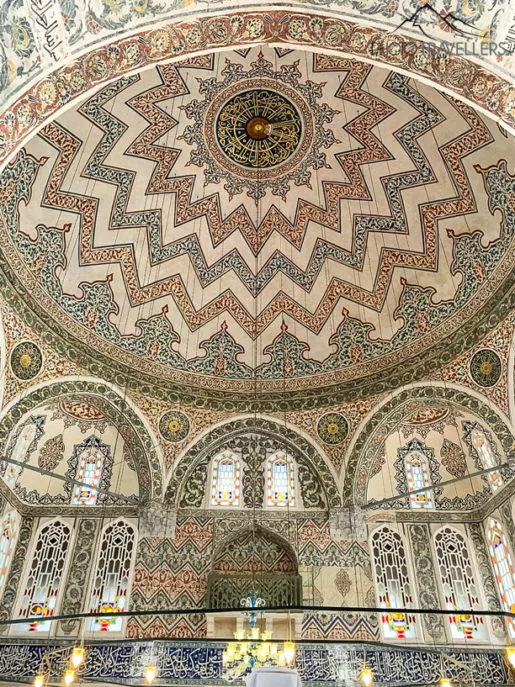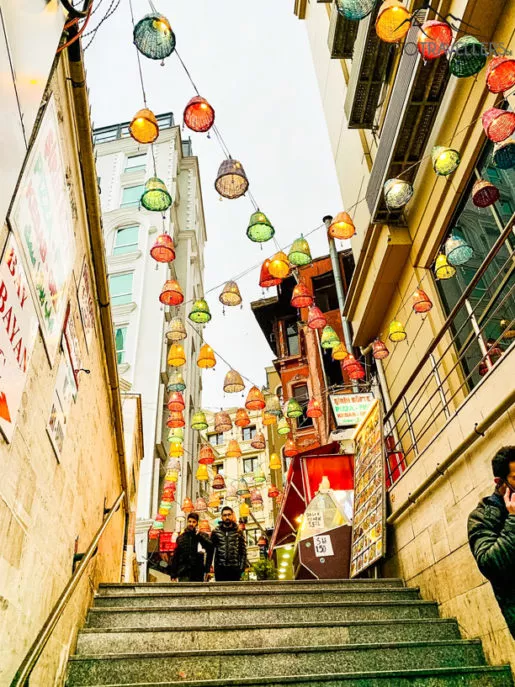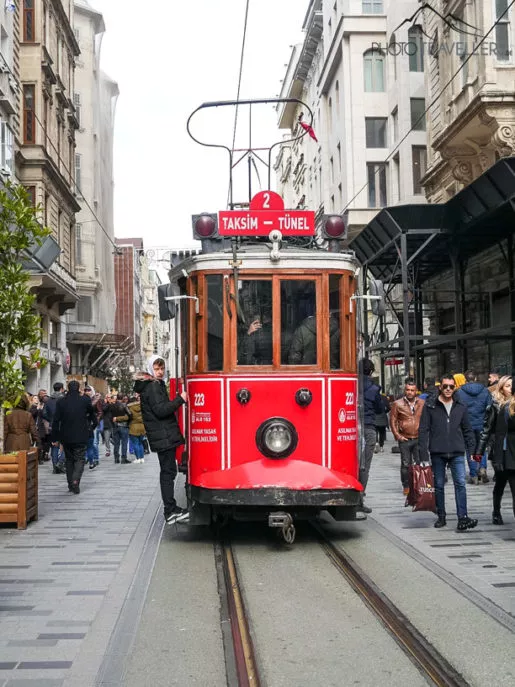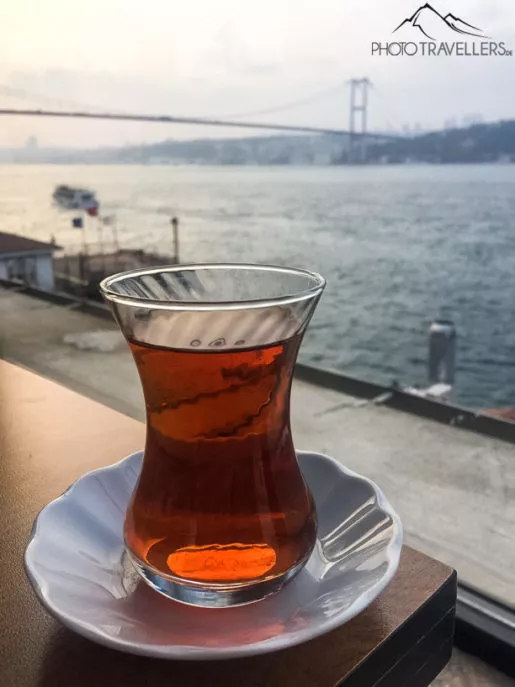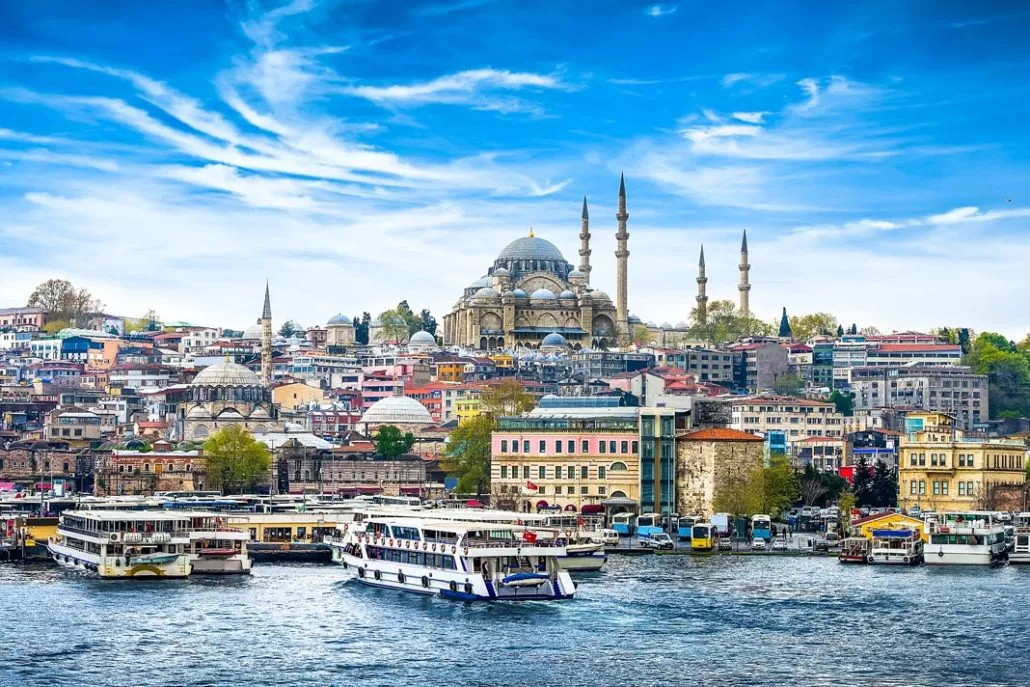
Top things to do in Istanbul: 15 beautiful sights to see [+ map]
Istanbul is one of the most impressive cities in the world, if only because of its unique location between two continents. Even today, the Bosphorus divides Istanbul into European and Asian parts.
The city also looks back on 2600 years of history. It was founded as Byzantium, later it was called Constantinople, and finally Istanbul.
Therefore, today's cityscape of Istanbul is characterized by different eras, especially Greco-Roman antiquity, the Middle Ages, and modern Turkey.
Parts of the historic peninsula, which is located on the European side, have therefore even been declared a UNESCO World Heritage Site.
Here, therefore, I take you on a tour of the 16 most exciting sights in Istanbul. However, we will not only look around the historic old town but also take a look at other highlights of the Turkish metropolis. Be curious!

Hi! Wir sind Biggi & Flo
Wir nehmen dich als Reisejournalisten mit zu den schönsten Orten der Welt!
Werbehinweis: Alle mit einem * markierten Links sind Werbelinks.
The top 15 sights at a glance

We tell you the top highlights, the most popular neighborhoods, the coolest places to chill, but also really good restaurants and nice hotels in Istanbul.
You want to know what to do in Istanbul? Then come with us to one of the most exciting cities in the world. First of all, here is an overview of our top 15 sights to see in Istanbul.
- Blue Mosque
- Hagia Sophia
- Cisterna Basilica
- Topkapi Palace
- Dervish dances in the cultural center Hodjapasha
- Relaxing in the Hamam
- Grand Bazaar
- Suleymaniye Mosque
- Balat
- Galata Quarter with Galata Tower and Galata Bridge
- İstiklal Caddesi and Taksim Square
- Dolmabahçe Palace
- Bosphorus Bridge and Ortaköy Mosque
- Leander Tower
- Rumelian Fortress
1. Blue Mosque
Probably the most famous landmark of Istanbul is the Blue Mosque (Google Maps). Its actual name is Sultan Ahmed Mosque, named after the client Sultan Ahmed I.
It is called the Blue Mosque because of the many blue and white tiles inside, which were added after the mosque was completed in 1616. They mainly decorate the dome, while the rest of the structure is adorned with detailed İznik tiles depicting various plants.
Another special feature of the Sultan Ahmed Mosque is the six minarets. The reason for this number is rather curious: Supposedly, the sultan wanted golden minarets (“gold” means “altın” in Turkish), but the budget was not enough for that. Therefore, the architect pretended to have misheard and instead understood “altı” – which means “six”. By the way, there are only two mosques with more than six minarets, and they are in Medina and in Mecca.
Entry to the mosque is free outside prayer times and is through the visitors’ entrance. Men must cover their shoulders and legs only, and women must additionally cover their hair. Shoes must also be removed.
However, not only the Blue Mosque itself is spectacular, but also the surrounding park area and the Sultan Ahmed Square of the same name. In former times there was a horse racing track here, today it is the historical center of Istanbul. From here you can reach many of the important sights on foot.
2. Hagia Sophia
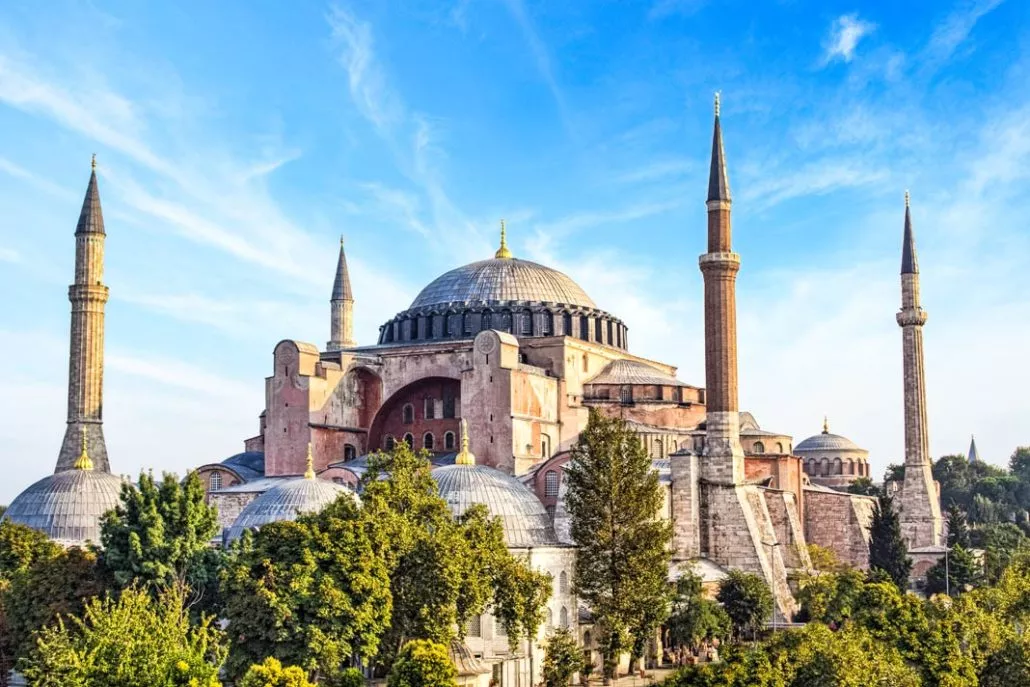
However, the main mosque of Istanbul is not the Blue Mosque, but the Hagia Sophia (Google Maps), which is only a few meters away.
It is also called Sophia Church in German and has a turbulent history. In fact, Hagia Sophia was built as a Byzantine church as early as 532 AD but was used as a mosque from 1453 to 1935. After that, at the request of the Turkish state founder Atatürk, it housed a museum until 2020, and since then it has once again become the city’s main mosque.
The church is based on a complicated geometric building concept, which gives it its extraordinary overall appearance and makes it one of the most important buildings in the world. Particularly imposing is the huge dome, which is supported by only four pillars and is therefore unique in this size to this day.
When St. Sophia’s Church was converted into a mosque in 1453 during the Ottoman conquest of Constantinople, Christian symbols and decorations were covered up. Today, the remaining mosaics and marble decorations from the Byzantine period have been uncovered and can be admired by visitors.
However, it is not unproblematic that Hagia Sophia is being used as a mosque again today – it remains an important symbol for Orthodox Christians worldwide, who feel betrayed by Erdoğan’s probably politically motivated decision. Moreover, it failed to send an important signal for peaceful coexistence between religions and respect for other cultures.
Tip: Another Byzantine church in Istanbul, which has since been converted into a museum and has been used as a mosque since 2020, is the Chora Church (Google Maps). And speaking of churches – there are also several Roman Catholic churches in Istanbul, for example, the beautiful Basilica of St. Anthony (Google Maps) in the middle of the city.
3. Cisterna Basilica
Hiding virtually directly across from Hagia Sophia is my absolute favorite among the top sights in Istanbul – the Cisterna Basilica (Google Maps). It’s a stunning thing to do in Istanbul!
It is often referred to as the Sunken Palace and is actually called the Yerebatan Cistern. This is because the Cisterna Basilica is not a basilica, but actually the largest preserved water cistern from ancient Constantinople. The name can be explained by the fact that there was a large basilica above the cistern.
However, the interior of the cistern itself can easily be mistaken for a cathedral. Indeed, the underground hall is almost 140 meters long and 65 meters wide and is supported by a total of 336 eight-meter-high columns.
The reflection of the columns in the water – in which you can even spot a fish or two – is really impressive. Sometimes there are even light installations or classical music. Even an underground café belongs to the Cisterna Basilica today.
Another highlight is the stone Medusa heads that serve as pedestals for some of the columns. Maybe you can spot them during your visit!
The Yerebatan Cistern has not only been used as a water reservoir for the Great Palace but has also been the backdrop for several Hollywood movies. You might know it, for example, from “James Bond 007 – Love Greetings from Moscow” or “Inferno” from the Da Vinci Code series.
Tip: Less known are for example the Theodosius Cistern (Google Maps) or the Philoxenos Cistern (Google Maps).
⭐ The perfect travel guide for your vacation in Istanbul
History, culture, sightseeing, and modernity – this travel guide simply has everything you could need for a successful stay in Istanbul. Take a look at one of the famous works of Rick Steves Istanbul: With Ephesus & Cappadocia (get it here*). You should also take a look at Lonely Planet Istanbul 10 (get it here*).
4. Topkapi Palace
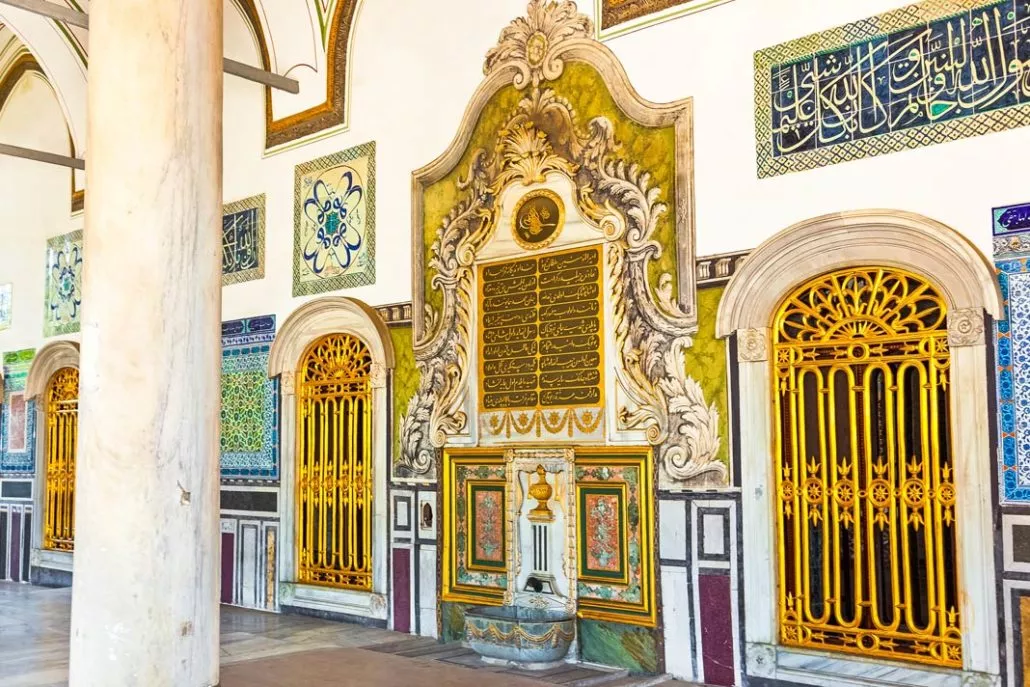
Moving on, a royal sight is also just around the corner. The Topkapi Palace (Google Maps), which translates as Cannon Gate Palace and goes back to the cannon foundry located in the palace, occupies an enormous area on the headland of the historic peninsula.
This gives you a unique view of Istanbul from here. Due to its strategic location, a Byzantine palace was built on the same site as early as the 9th century, which was expanded or built over after the conquest of Constantinople in 1453. In the 18th century it was finally added again and today it is divided into four courtyards.
In between, the sultans resided here for centuries before moving to Dolmabahçe Palace. But I’ll tell you more about that later!
Inside the Topkapi Palace, elaborately designed mosaics and architectural masterpieces await you. For example, you can visit the sultan’s living quarters, the treasury, and the throne room.
The highlight, however, is the harem, where in ancient Istanbul up to 2,000 harem ladies were housed. Since the palace is also used as a museum today, numerous artifacts such as Islamic relics, robes, jewels, weapons, portraits, and an ancient recipe book from the court pharmacy are also displayed there.
Since the Topkapi Palace is really huge – at times even up to 5,000 people lived here – you should take at least three hours to visit this impressive attraction. Also, it is always very busy here, so it is best to get tickets in advance.
5. Dervish Dances at the Hodjapasha Cultural Center
The next sightseeing attraction is not an insider’s tip, but for me, it is definitely one of the must-dos in Istanbul. The dervish dances in the cultural center Hodjapasha (Google Maps) are really extremely impressive!
In general, dervishes are members of a Muslim religious community. Specifically, we are talking about the Mevlevi order, which is considered one of the most famous Sufi brotherhoods.
The dance, which the monks have been performing for more than 800 years, is considered a method of falling into religious ecstasy and having contact with God. It is called Sema and consists of seven parts. The dervishes, dressed in their white, plate-like robes, gracefully turn in a circle, which is said to symbolize the birth of humanity.
The ceremony is accompanied by classical Turkish music and prayer. Poems by Rumi, the eponym of the Mevlevi order, or the Al-Fātiha, the first sura of the Koran, are often read.
Another cool thing to do in Istanbul is the venue. The Hodjapasha Cultural Center is located in a former bathhouse from the 15th century. This setting creates a very special atmosphere and an authentic experience of traditional Turkish culture.
Well, could I convince you? If so, click here to go directly to the website of the cultural center.
6. Relaxing in the Hamam
The next activity should not be missed during your Istanbul trip. It’s about visiting a hamam, a Turkish bathhouse- a cool thing to do in Istanbul.
There are several of these in Istanbul’s old city, usually in close proximity to a mosque. This is because the main purpose of the hamam is to perform the ghusl. This is the name given to the general washing of the body in Islam, which is performed before Friday prayers, for example.
Later, private hamams were also built for wealthy residents. But they all have one thing in common: their construction. This has hardly changed since the beginning of the bathing tradition. First, you take off your clothes and go with towel or bathing clothes to the next area of the hamam. This is heated, while the heat and humidity increase the closer you come to the center of the building. There you can then undergo a massage, for example, and then rest.
Among the most popular hamams are the Çardaklı Hamamı (Google Maps) and the Kılıç Ali Paşa Hamamı (Google Maps).
Very special tips are also the Çemberlitaş Hamamı (Google Maps), which was built as early as 1584 by the famous Ottoman architect Sinan, and the Fatih Hamamı (Google Maps) with great ceramic mosaics and a large swimming pool- a fun thing to experience.
The Cağaloğlu Hamam is located in the Sultanahmet district and is over 300 years old. It was the last one to be built during the Ottoman Empire. It has served as a prop for many movies and famous personalities such as Kaiser Wilhelm, Franz Liszt, and Tony Curtis have been guests here.
7. Grand Bazaar
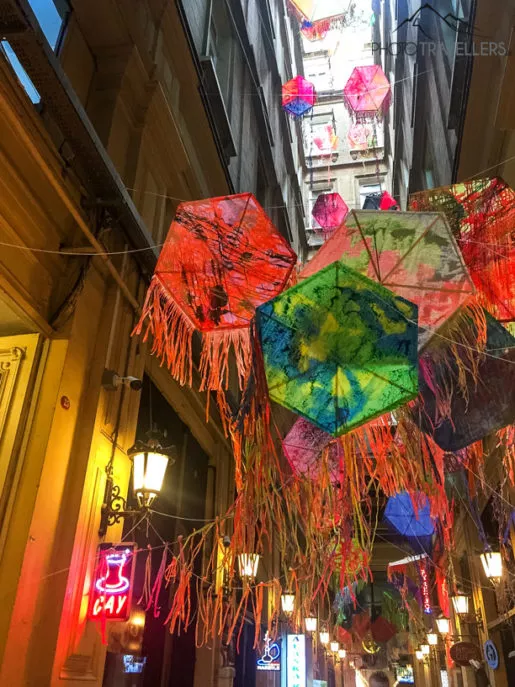
The next highlight is not long in coming – it’s the Grand Bazaar, Kapalı Çarşı in Turkish (Google Maps).
Where to visit it? You’ll find this top place to go very close to the Çemberlitaş-Hamam and you should definitely visit it. What’s in Grand Bazaar to do? There are around 4,000 different merchants here, offering carpets, leather goods, fabrics, or jewelry, for example.
The stores are arranged according to branches, which you can recognize by the names of the individual sections. For all bookworms, for example, the Sahaflar Çarşısı, the book bazaar, is the right address.
You only have to be careful with antiques, as strict customs regulations apply here. Export from Turkey is forbidden and punishable by up to ten years in prison. So always make sure, for example with old carpets, that they are not antique goods.
The center of the bazaar is the Old Cloth Hall, which was originally planned as a treasury. Therefore, the gold and silver merchants are still at home under the large domes.
The Grand Bazaar was founded in the 15th century after the conquest of Constantinople. Since then, it has been the city’s most important trading and shopping center. However, the bazaar was originally made entirely of wood – but after it had several times to severe fires, the individual buildings were gradually rebuilt in stone.
Today, the Grand Bazaar is completely covered and is always open on weekdays. Every day about 500,000 visitors find their way to this popular attraction. Let yourself be carried away by the colorful hustle and bustle and haggle with the merchants for the hotly contested goods!
Tip: Around the Grand Bazaar there are other shopping streets, stores, and stalls. It’s a really amazing thing to do in Istanbul! You will also find there fish, fruit, and vegetable markets here, as well as the Egyptian Bazaar, Mısır Çarşısı in Turkish (Google Maps). It is also called the Spice Bazaar and was built a little later than the Grand Bazaar, in 1660.
8. Süleymaniye Mosque
The famous architect Sinan, who was responsible for the construction of the Çemberlitaş-Hamam, among others, also built the Suleymaniye Mosque (Google Maps) – an incredible thing to do in Istanbul!
It is the second largest mosque in the city after the Blue Mosque and another of its landmarks. This is due to the fact that it was built on one of the seven hills of Istanbul and thus dominates the skyline.
The mosque was commissioned by Suleyman the Magnificent, who was one of the most important Ottoman rulers. The four minarets with a total of ten balconies are also dedicated to him – he was the fourth sultan after the conquest of Constantinople and thus the tenth sultan of the Ottoman Empire.
The mosque complex was later expanded and, in addition to a large garden, included the sultan’s mausoleums, a soup kitchen, a hostel, a hospital, several schools, and an astronomical observatory.
A real highlight is a library, which contains the world’s largest collection of Islamic manuscripts. It also includes a restoration workshop where they take care of the valuable ancient writings.
From the outside and also from the inside, the Süleymaniye Mosque impresses with its monumental simplicity. It is also known for its breathtaking panoramic view of the city – as you remember, the mosque is located at the top of a hill. So, when it’s open, be sure to visit the north terrace!
9. Balat
We’re now leaving the Old City for the northwest because that’s where the Balat neighborhood is (Google Maps). More precisely, Balat is the Jewish quarter of the Fatih district and one of the best places you must see.
In the past, mainly Sephardic Jews lived here, but later Greeks and Armenians joined them. Therefore, this area is most famous for the mixture of Greek and Armenian churches and Jewish synagogues.
One of the most spectacular is the Ahrida Synagogue, the oldest synagogue in Istanbul. Its distinctive rust-red facade is a result of renovations in the 17th century. You can capture the synagogue in a particularly impressive way from one of the lower-lying alleys.
Balat is famous for its narrow streets and colorful houses. Here, thousands of colorful motifs are waiting to be discovered by you. A trip to this district is a must for all photography enthusiasts!
You should also visit one of the cute cafes in Balat and try the delicious coffee. And art lovers and antique collectors are sure to find what they are looking for in this traditional district. These are definitely some cool things to do in Istanbul.
10. Galata Quarter with Galata Tower and Galata Bridge
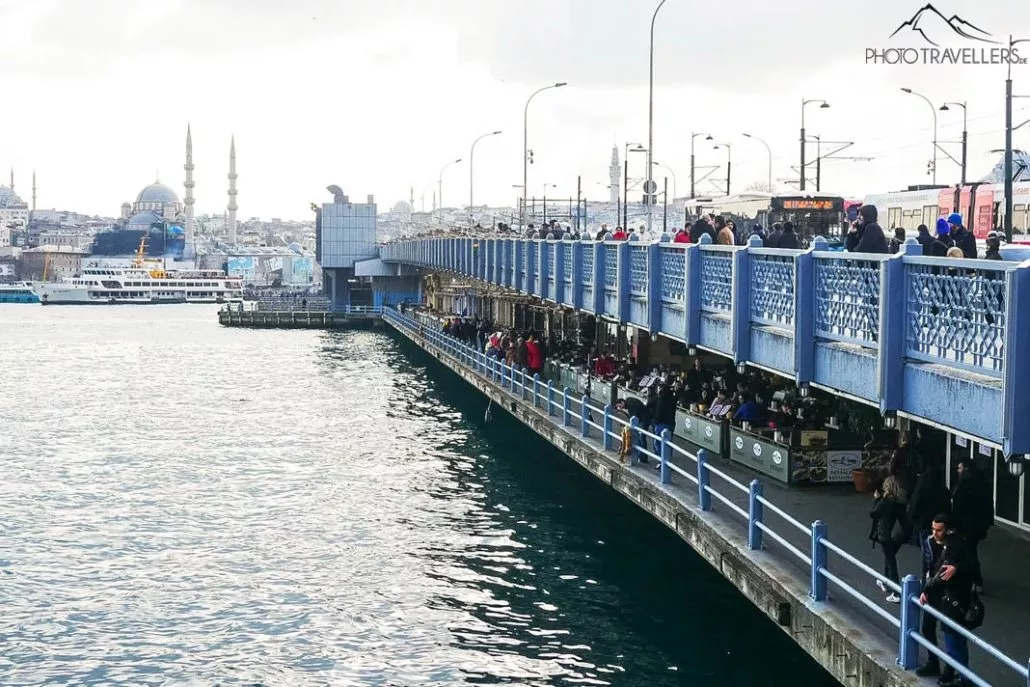
Now we cross the Golden Horn, the approximately seven kilometers long estuary that separates us from the next sights. The best and most popular way to do this is via the Galata Bridge (Google Maps), which is crossed by about half a million people every day.
It connects the old city of Istanbul with the younger part, which includes the famous Galata Quarter (Google Maps). The name indicates that there used to be Celtic settlements here – by the way, this is also the case with Gaul or Galicia. Today, the district is actually no longer called Galata, but Karaköy – but you may still know the old name from the Galatasaray Istanbul soccer club.
In Byzantine times, Galata was even its own city, where rich merchants settled. Today, the neighborhood is known for its nightlife. For example, a popular pub crawl in Istanbul starts at the Tower Pub.
The name of the pub has its origin in the fact that it is located right next to the famous Galata Tower (Google Maps). This was originally once part of the city’s fortifications but was then also used as a prison, fire station, and possibly even a lighthouse. Today, the nine-story tower is one of Istanbul’s most beautiful viewpoints.
However, the elevators in the tower only go up to the seventh floor, so you have to climb the last part of the tower, which is over 60 meters high, via a wooden spiral staircase. But the panoramic view from the observation deck makes up for the effort. There is also a restaurant up there- a secret place where you can enjoy the panorama at its best.
Tip: The Galata Bridge is not only suitable for crossing the Golden Horn. It is also known for the many fish restaurants below the bridge and the street food stalls on the south side. Visit those is a very cool thing to do in Istanbul!
11. İstiklal Caddesi and Taksim Square
The famous shopping street İstiklal Caddesi (Google Maps) also begins in the Galata district. What’s to see here? There are stores, boutiques, restaurants, and bars without end. Even on Sundays, the stores here are open until 10 pm. It’s a cool thing to do in Istanbul!
İstiklal Caddesi is also famous for the historic red streetcar, which is one of the most popular sights and photo opportunities in Istanbul. In addition, on the street, you will find one of the world’s largest collections of houses in the Art Nouveau style. In the past, mainly international bankers lived here.
The end of the shopping street is Taksim Square (Google Maps). Together with İstiklal Caddesi, it is considered the center of Istanbul’s nightlife – so similar to the Galata district, there is always something going on here.
In addition, Taksim Square is the main traffic junction of the European part of Istanbul. In the center of the square is the Monument to the Republic, which is meant to commemorate the founding of Turkey in 1923. Taksim Meydanı, as it is called in Turkish, also received attention a good 90 years later – namely, in 2013, major protests against Turkish Prime Minister Recep Erdoğan took place here.
If you are looking for a green oasis in the city, Taksim Square is also the right address. In fact, this is where Gezi Park is located, the largest of the few inner-city green spaces in Istanbul. It was the prevention of its construction that triggered the 2013 protests in the first place – unfortunately, the controversial construction project is still not completely off the table.
12. Dolmabahçe Palace
From the bustling city center, we continue to the shore of the Bosporus. Here stands the Dolmabahçe Palace (Google Maps), named after the bay of the same name. It’s a wonderful place to visit!
In the 17th century, a royal garden was laid out here, where several small castles and summer residences were located. That is why the Dolmabahçe Palace is still called the “palace full of gardens”.
In 1856, the palace officially became the residence of the sultans who moved here from Topkapi Palace. This is because Sultan Abdülmecid I wanted to adapt to the Central European standards because the Ottoman Empire’s relations with this region were getting stronger.
So, he commissioned two Armenian architects with European training to design the Dolmabahçe Palace in the style of the Turkish Renaissance, but with French and Italian Renaissance and Baroque elements. The construction project became quite expensive because, among other things, white marble and 14 tons of gold were used for the ceilings. Moreover, the largest chandelier in the world hangs in the central hall, which is called Muayede in Turkish – one of the best things to see in Istanbul!
In total, the royal residence has 285 rooms, 46 halls, 6 hamams, and 68 bathing rooms. It also includes a harem with eight apartments, which had to be completely sealed off from the outside world. That’s why, curiously, you don’t enter the palace in the middle of the building, but through the main entrance on the narrow south side. By the way, even today the palace is used for state visits.
The view from the Dolmabahçe Palace is also unique. You should definitely take a look through the Bosphorus Gate – it’s literally an archway right on the water, through which you have an excellent view of the strait and the Asian side of Istanbul.
Tip: Also, right on the water, but on the opposite Asian side of Istanbul, are the beautiful Kücüksu Palace (Google Maps) and the impressive Beylerbeyi Palace (Google Maps) – some really impressive things to do!
13. Bosphorus bridge and Ortaköy mosque
About three kilometers away from the Dolmabahçe Palace is the Bosphorus Bridge (Google Maps).
Officially, it is not even called that anymore, but Bridge of the Martyrs of July 15. On this date in 2016, when parts of the Turkish military attempted a coup, there were serious clashes here. The coup was eventually put down.
The Bosphorus Bridge was opened on October 29, 1973, the 50th anniversary of the Turkish Republic. Initially, it was open for pedestrians, but after four years it became a pure traffic bridge due to numerous suicides.
Today there are six lanes, the direction of which is not fixed. It depends on the day of the week, the time of day, and the flow of traffic – during rush hour, for example, four of the lanes lead from the Asian side to the European side in the morning and vice versa in the evening, as most Istanbul residents work in Europe. A toll is only charged on the bridge when you drive from the Asian to the European continent. Also, since the bridge is relatively high at 64 meters, even large ships can easily pass under it.
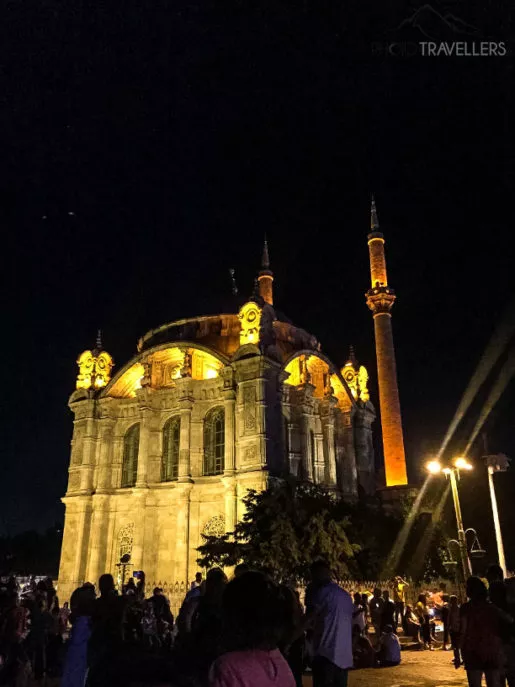
The Bosphorus Bridge is also a popular photo motif, especially in combination with the Ortaköy Mosque (Google Maps). It was designed in the New Baroque style and is not only pretty to look at from the outside – its interior is always flooded with light thanks to the many windows, which makes for quite a devotional atmosphere.
14. Leander Tower
When you cross the Bosphorus Bridge, you reach the Asian part of Istanbul. Here, on a small island about 180 meters from the shore, you will find an absolute top sight of the city: the Leander Tower (Google Maps).
There are many legends surrounding the tower and its name. For example, the name Leander Tower goes back to the ancient story of Leander, who swam every night to his beloved Hero. He was guided by a torch, which went out one night – Leander lost his bearings and drowned, whereupon Hero also threw himself into the water.
In Turkish, the lighthouse is called Kız Kulesi, which can be translated as “girls’ tower.” This, in turn, is due to another tragic story. It is about a princess who was predicted to die by poison. Her father then locked her in the tower to protect her – however, a fruit basket intended for the princess hid a snake that bit and killed her.
Another legend says that a large chain was attached to the Leander Tower, which was stretched across the Bosphorus when Byzantium was attacked. The other end was supposedly tied to the Mangana Palace opposite, where the Topkapi Palace is today.
The old lighthouse now houses a restaurant and café, from which you can enjoy an excellent view of Istanbul. You may also know the tower from the big screen – in the finale of the James Bond film “The World Is Not Enough”, the title character’s antagonist hides here. However, the interior shots were filmed in the studio. A very cool thing to do in Istanbul!
You can reach the Leander Tower by boat from Üsküdar (Google Maps). It leaves every 15 minutes, while the ferry from the European side only crosses every hour.
Tip: Another of the many sights on the Asian side of Istanbul that you should definitely visit is the Süreyya Opera House (Google Maps). What to see there? It’s the home of the Istanbul State Opera and State Ballet.
15. Rumelian Fortress
Further north than the previous sights is the Rumeli Fortress (Google Maps) or Rumeli Hisarı – a spectacular thing to do in Istanbul!
It was built in 1452 in preparation for the siege of Constantinople, by 3,000 workers in just four months. Sultan Mehmed II chose as its location the narrowest part of the Bosphorus, 700 meters, to block ships coming from the Black Sea from the Rumeli Fortress and the Anatolian Fortress opposite.
Despite all efforts, Constantinople was taken nine months later and the Rumelic Fortress was turned into a prison. In 1953, on the 500th anniversary of the conquest of Constantinople, it was restored and has housed a museum since then. Moreover, famous Turkish musicians give concerts here every summer.
Due to its location on the hillside, the round towers, and the high walls, the Rumelian Fortress looks a bit like a castle from Game of Thrones. Almost like Dubrovnik! Rightly so, the Rumelian Fortress is one of the most beautiful castles in Europe – you can find more information about the fortress there.
Very close to the Rumelian Fortress is the Second Bosphorus Bridge, also known as Fatih Sultan Mehmet Bridge (Google Maps). It, too, is only open to cars and is subject to tolls.
Tip: Panoramic view from Pierre Loti Hill
Finally, we head out of the city a bit to admire it from afar. And probably one of the best views of Istanbul is offered by Pierre Loti Hill (Google Maps).
It was named after the French writer Pierre Loti, who spent a lot of time in Istanbul. It is rumored that he fell in love with a married woman here, whom he met every day in the café on the hill. That is why the café still bears his name.
The easiest way to get to the top of the hill is by cable car. Once at the top, there is not only the Pierre Loti Café but also other restaurants and tea gardens. And of course, the excellent view!
But especially exciting is the Eyüp Sultan Mosque, located just outside the ancient city walls on the hill. Here is said to be the tomb of Abu Ayyub al-Ansari, Muhammad’s companion and standard-bearer. He died during the first siege of Constantinople in the 7th century. The mosque is therefore an important pilgrimage site for Muslims today.
Tip: You can also get a great view of the city from Çamlıca Hill (Googel Maps).
The top 5 secret tips at a glance
Among the absolute top places to see are definitely the famous Blue Mosque, the Hagia Sophia, the Topkapi Palace, the Bosphorus Bridge, and the Grand Bazaar. However, there are also great insider tips and secret places, led by these five:
- Cisterna Basilica
- Relaxing in the Hamam
- Balat
- Rumelian Fortress
- Panoramic view from Pierre Loti Hill
Additional tips and day trips
Of course, that’s not all you can do and experience in Istanbul. Art lovers, for example, should not miss the İstanbul Modern, a museum of modern art.
To get to know the city from a different perspective, you can also take a boat trip on the Bosphorus. The Bosphorus ferry to Asia is also suitable for this – and then you can directly visit the many sights on the Asian side of Istanbul. Another tip to save time and money is the Istanbul Welcome Card (website), with which you can get admission to various attractions, use transportation, and also take a Bosphorus tour.
Speaking of ferries, you can also reach the Prince Islands (Google Maps) in about 90 minutes by ferry from Istanbul. This small group of islands lies in the Sea of Marmara off the Asian side of the city and has been home to several monasteries since Byzantine times, where monks and exiles were housed. The largest of the islands is Büyükada, where cars are prohibited and horse-drawn carriages and bicycles are as much a part of daily life as old, grand villas. The island is considered a resort and should definitely be on your list if you have some extra time in your luggage.
Last but not least, a few day trips could also be on your agenda if you want to explore the surroundings of Istanbul. For example, the historic Gallipoli Peninsula (Google Maps) on the European continent is about four hours away. The ancient ruined city of Troy (Google Maps), on the Asian side, takes just under six hours. Bursa (Google Maps), the former capital of the Ottoman Empire, is also about halfway there. There are also guided day tours to all places.
What else you should know about Istanbul
- Istanbul has about 15.5 million inhabitants
- This makes Istanbul the most populous city in Turkey
- With more than 14 million tourists per year, Istanbul is also the eighth most visited city in the world.
- In 2010 Istanbul was the European Capital of Culture
